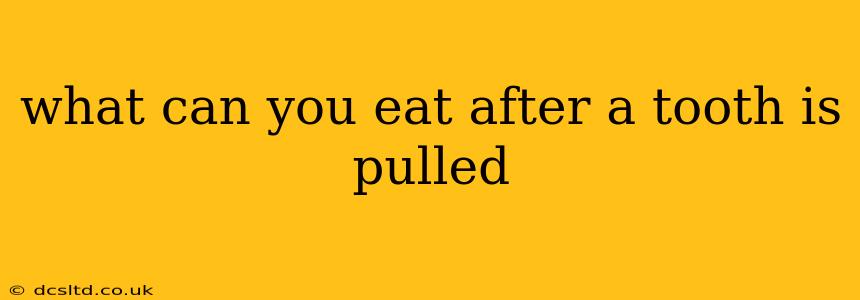What Can You Eat After a Tooth is Pulled? A Guide to Post-Extraction Nutrition
Having a tooth pulled can be a bit of a jarring experience, and knowing what to eat afterward is crucial for a smooth recovery. The key is to consume soft, easily digestible foods that won't irritate the extraction site while providing the nutrients your body needs to heal. This post will guide you through safe food choices and address common questions surrounding post-extraction diets.
Understanding the Healing Process
After a tooth extraction, a blood clot forms in the socket to initiate the healing process. This clot is incredibly delicate and can be dislodged by eating the wrong foods, leading to a painful and potentially serious complication called dry socket. Therefore, avoiding anything that could disturb this clot is paramount in the first few days.
What Foods to Eat After Tooth Extraction?
In the immediate aftermath (the first 24-48 hours), focus on liquids and extremely soft foods. Here are some excellent options:
- Smoothies: Blend fruits, vegetables, yogurt, and even protein powder for a nutritious and easy-to-consume meal. Avoid using a straw, as the suction can dislodge the clot.
- Soups: Opt for broth-based soups with finely chopped vegetables or pureed options. Avoid chunky soups or those with hard ingredients.
- Applesauce: A classic choice for its soft texture and sweetness.
- Yogurt: High in protein and calcium, yogurt is a great source of nutrients during recovery. Choose plain varieties to avoid added sugars.
- Mashed Potatoes: A comfort food that’s easy on the gums.
- Oatmeal: Cooked oatmeal, especially when blended slightly, is gentle and nutritious.
- Scrambled Eggs: Ensure they are well-cooked and soft.
As Healing Progresses (Days 3-7 and Beyond):
As the extraction site begins to heal, you can gradually introduce more foods into your diet. However, continue to avoid anything hard, crunchy, or sticky that could irritate the area. Good options include:
- Soft Cooked Vegetables: Steamed or well-cooked carrots, peas, and green beans are all good choices.
- Pasta: Choose well-cooked pasta with soft sauces.
- Well-Cooked Fish: Flaky fish like cod or salmon are easy to chew and rich in protein.
- Soft Cheeses: Cottage cheese or ricotta cheese are good sources of protein and calcium.
What NOT to Eat After Tooth Extraction?
Avoiding certain foods is equally important as choosing the right ones. Stay away from these until your extraction site is fully healed:
- Hard foods: Avoid anything that requires significant chewing, such as nuts, chips, crackers, hard candies, and popcorn.
- Spicy foods: These can irritate the sensitive gum tissue.
- Extremely hot or cold foods: Temperature extremes can cause discomfort.
- Sticky foods: Sticky foods like caramel or gummy candies can adhere to the extraction site and dislodge the blood clot.
- Foods that require excessive chewing: Avoid anything that requires a lot of effort to chew, as this can put undue stress on the extraction site.
- Alcohol: Avoid alcohol until your dentist advises otherwise, as it can interfere with healing.
What if I’m Experiencing Pain or Swelling?
Pain and swelling are common after a tooth extraction. Follow your dentist's instructions regarding pain medication and ice application. If the pain is severe or doesn't improve, contact your dentist immediately.
How Long Should I Avoid Certain Foods?
It’s best to avoid hard, crunchy, sticky, and spicy foods for at least a week. Your dentist can provide a more specific timeline based on your individual healing progress. Always listen to your body—if something feels uncomfortable to eat, it's best to avoid it.
What About Straws and Smoking?
Avoid using straws and smoking in the days immediately following a tooth extraction because the suction can dislodge the blood clot and lead to dry socket.
Following these guidelines will help ensure a smooth and comfortable recovery after your tooth extraction. Remember to consult with your dentist or oral surgeon if you have any concerns or questions. They can provide personalized advice based on your specific situation.
